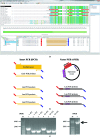Gene design, cloning and protein-expression methods for high-value targets at the Seattle Structural Genomics Center for Infectious Disease
- PMID: 21904039
- PMCID: PMC3169391
- DOI: 10.1107/S1744309111026698
Gene design, cloning and protein-expression methods for high-value targets at the Seattle Structural Genomics Center for Infectious Disease
Abstract
Any structural genomics endeavor, particularly ambitious ones such as the NIAID-funded Seattle Structural Genomics Center for Infectious Disease (SSGCID) and Center for Structural Genomics of Infectious Disease (CSGID), face technical challenges at all points of the production pipeline. One salvage strategy employed by SSGCID is combined gene engineering and structure-guided construct design to overcome challenges at the levels of protein expression and protein crystallization. Multiple constructs of each target are cloned in parallel using Polymerase Incomplete Primer Extension cloning and small-scale expressions of these are rapidly analyzed by capillary electrophoresis. Using the methods reported here, which have proven particularly useful for high-value targets, otherwise intractable targets can be resolved.
Figures





Similar articles
-
Multi-target parallel processing approach for gene-to-structure determination of the influenza polymerase PB2 subunit.J Vis Exp. 2013 Jun 28;(76):4225. doi: 10.3791/4225. J Vis Exp. 2013. PMID: 23851357 Free PMC article.
-
Crystallization and X-ray crystallographic analysis of the cap-binding domain of influenza A virus H1N1 polymerase subunit PB2.Acta Crystallogr Sect F Struct Biol Cryst Commun. 2013 Mar 1;69(Pt 3):280-3. doi: 10.1107/S1744309113002388. Epub 2013 Feb 22. Acta Crystallogr Sect F Struct Biol Cryst Commun. 2013. PMID: 23519804 Free PMC article.
-
Structural genomics of infectious disease drug targets: the SSGCID.Acta Crystallogr Sect F Struct Biol Cryst Commun. 2011 Sep 1;67(Pt 9):979-84. doi: 10.1107/S1744309111029204. Epub 2011 Aug 13. Acta Crystallogr Sect F Struct Biol Cryst Commun. 2011. PMID: 21904037 Free PMC article.
-
The Seattle Structural Genomics Center for Infectious Disease (SSGCID).Infect Disord Drug Targets. 2009 Nov;9(5):493-506. doi: 10.2174/187152609789105687. Infect Disord Drug Targets. 2009. PMID: 19594426 Free PMC article. Review.
-
Structural genomics and drug discovery for infectious diseases.Infect Disord Drug Targets. 2009 Nov;9(5):507-17. doi: 10.2174/187152609789105713. Infect Disord Drug Targets. 2009. PMID: 19860716 Free PMC article. Review.
Cited by
-
Artificial neural networks trained to detect viral and phage structural proteins.PLoS Comput Biol. 2012;8(8):e1002657. doi: 10.1371/journal.pcbi.1002657. Epub 2012 Aug 23. PLoS Comput Biol. 2012. PMID: 22927809 Free PMC article.
-
Gene Composer in a structural genomics environment.Acta Crystallogr Sect F Struct Biol Cryst Commun. 2011 Sep 1;67(Pt 9):985-91. doi: 10.1107/S1744309111027424. Epub 2011 Aug 13. Acta Crystallogr Sect F Struct Biol Cryst Commun. 2011. PMID: 21904038 Free PMC article.
-
Multi-target parallel processing approach for gene-to-structure determination of the influenza polymerase PB2 subunit.J Vis Exp. 2013 Jun 28;(76):4225. doi: 10.3791/4225. J Vis Exp. 2013. PMID: 23851357 Free PMC article.
-
Crystal structure of chorismate mutase from Burkholderia phymatum.Acta Crystallogr F Struct Biol Commun. 2018 Apr 1;74(Pt 4):187-192. doi: 10.1107/S2053230X18002868. Epub 2018 Mar 22. Acta Crystallogr F Struct Biol Commun. 2018. PMID: 29633965 Free PMC article.
-
Crystal structure of a short-chain dehydrogenase/reductase from Burkholderia phymatum in complex with NAD.Acta Crystallogr F Struct Biol Commun. 2022 Feb 1;78(Pt 2):52-58. doi: 10.1107/S2053230X22000218. Epub 2022 Jan 27. Acta Crystallogr F Struct Biol Commun. 2022. PMID: 35102893 Free PMC article.
References
-
- Gaberc-Porekar, V. & Menart, V. (2001). J. Biochem. Biophys. Methods, 49, 335–360. - PubMed
-
- Gräslund, S., Sagemark, J., Berglund, H., Dahlgren, L. G., Flores, A., Hammarström, M., Johansson, I., Kotenyova, T., Nilsson, M., Nordlund, P. & Weigelt, J. (2008). Protein Expr. Purif. 58, 210–221. - PubMed
-
- Klock, H. E., Koesema, E. J., Knuth, M. W. & Lesley, S. A. (2008). Proteins, 71, 982–994. - PubMed
-
- Mossessova, E. & Lima, C. D. (2000). Mol. Cell, 5, 865–876. - PubMed
Publication types
MeSH terms
Substances
Grants and funding
LinkOut - more resources
Full Text Sources

